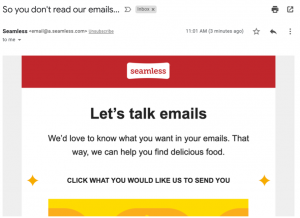You grab your morning—or afternoon?—cup of coffee, pop open your email, and start skimming your inbox. You see the usual emails from brands, a few subscriptions or newsletters, and maybe a note from family or friends. You know which ones you’re going to open and which ones will go straight to the trash— I always open up emails from Peloton, The Skimm, and the vendors making my 2021 wedding happen.
As the digital marketing landscape continues to evolve, email will continue to play a critical role in omnichannel campaigns. More than 2.9 billion people worldwide use email, and nearly 246 billion emails are received per day as of 2019.
So, whether they realize it or not, as consumers skim their inundated inbox, the fate of their emails rests on two things:
- Brand name
- Subject lines
A strong brand—one that gets its emails opened— has an established personal relationship with its email receiver, who exists somewhere between flirting with brand loyalty and full-blown brand advocate on the brand affinity spectrum. A person is on this scale even if they are a new addition to your CRM because they took the action of signing up on your website for whatever you were offering them. This person was intrigued enough to visit your website and interested enough to pass over a sacred point of connection—access to their inbox.
That brings us to the other factor that can keep your email out of the trash bin: the subject line.
Your email marketing is only as good as your subject line. If you do not have a good subject line, it does not matter how beautifully designed your email is, or how much research you did to land on that perfect CTA you know will drive industry-leading click-through rates. If no one opens your email in the first place, they won’t see it.
You need to put the same level of work into your subject lines as you would when designing, writing the content for, and determining CTAs for your email.
Here are four ways to improve your email open rates:
1. Be clear and straightforward.
Remember—the point of your email is for someone to open it. The subject line should tease the customer about what they might find if they do open the email. So, make sure the messaging of your subject line gets across exactly what you want to convey to the customer and nothing more—don’t overcomplicate your approach. For example, if you are running a promotion or a sale, lead with that in the subject line: “Just for you: 30% off our spring collection!” or this example that I personally received from Seamless:

2. Leverage personalization properly.
Personalization drives performance in nearly every marketing channel. With a CRM, there are many ways you can make an email personally relevant to your audience. Personalization is critical in establishing a one-to-one relationship with your customers and can make a difference when deployed effectively, so let’s consider these questions:
What customer data do you have?
What do you do with the customer data that you have?
How do you use it to fuel the messaging in the email and the subject line?
Whatever you do, ensure the data cells are correctly populating so that you don’t end up in a cringe-worthy “Hi [FNAME]” situation.
3. Determine your style.
Your email subject line is just one more critical extension of your brand. The messaging that makes up your subject line must ladder up to your brand’s overarching messaging style, tone, and voice. Determining your style and being consistent across all marketing channels will set your audience’s expectations as subscribers. Are you funny, conversational, serious, bold, or maybe completely off-the-wall? Figure out a style and stick to it.
4. Don’t test for testing’s sake.
Testing is, of course, a great way to improve performance. But before you start running tests, you must figure out your current email performance and set benchmarks so that you can see actionable results from your testing plan. Benchmarks such as these:
What is your current open rate?
What is the open rate by email type? For example, does a promotional email have a higher open rate than a newsletter?
What is your open rate by audience segment?
What is your email click-through rate?
What is your email conversion rate?
There are quite a few options you can explore when testing your subject lines. You can do the traditional A/B test, which splits your audience in half and sends two different subject lines to each audience, allowing you to see which one drove the better open rate. Another subject line test option is to send a small percentage of your audience list the email subject lines you want to test, and then send the winning subject line to the remaining audience. The possibilities are endless for email testing, so create a plan rooted in the foundation of your existing performance and go from there with optimizations. Just be careful not to test too many optimizations at once.
Bottom line? Give your subject lines some love. Monitor each email metric carefully to ensure you know where you can make tweaks to optimize your performance. Email marketing is not going anywhere anytime soon, and you need people to open your emails. As we move to a post-cookie world, the one-to-one customer relationship that brands desire will come back to the forefront of marketing strategies everywhere, and email marketing is in the driver’s seat.
